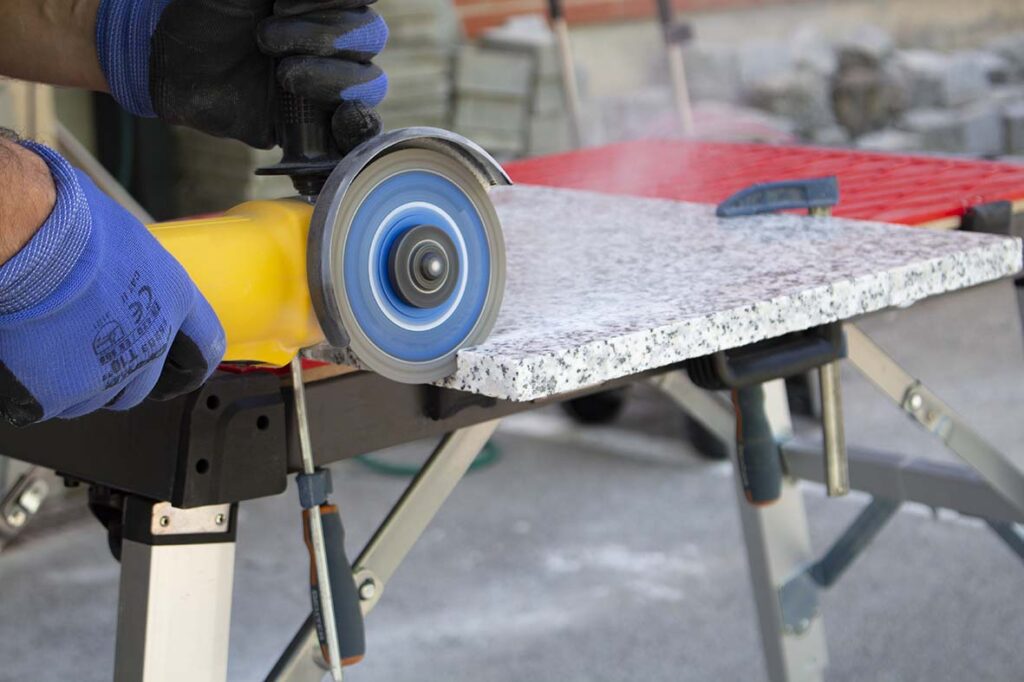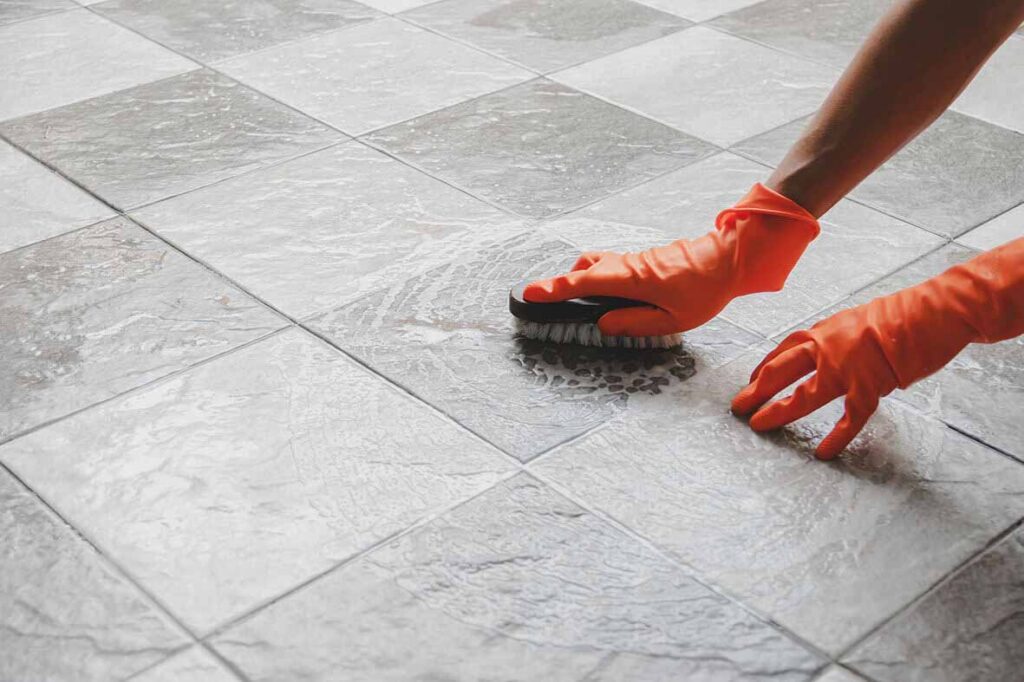Knowing how to work with natural stone tiles is a key part of learning how to tile. Natural stone tiles are a material that will never go out of style. Their robustness, uniqueness, and natural beauty is something that appeals to many people.
But how do you work with them? Do you need to prepare for working with them any differently than you do for porcelain and ceramic tiles? In this blog we will discuss everything you need to know for working with natural stone tiles.


NATURAL STONE TILES
Natural stone tiles, such as marble, limestone, travertine, slate, and granite, offer a diverse range of options for interior and exterior applications. Each type possesses unique characteristics that influence both their aesthetic appeal and functional properties.
MARBLE TILES
Marble, celebrated for its timeless elegance, is a classic choice for decorative purposes. It is available in various sizes, such as 12×12 inches, 18×18 inches, and larger formats. Marble can be finished in different ways, including polished for a glossy surface, honed for a matte finish, and leathered for a textured appearance that retains its natural colour variations.
When considering marble tiles, experts do not recommend using high gloss polished marble tiles as flooring, simply because the surface poses a high risk of slipping. Instead, opt for a regular polish, honed, or tumbled marble tile.
LIMESTONE AND TRAVERTINE TILES

Limestone, with its softer appearance, is commonly used for flooring and wall tiles. It comes in standard sizes like 12×24 inches and 18×18 inches.
Manufacturers often hone limestone tiles for a smooth, matte finish that highlights their natural beauty and colours.
Travertine, known for its distinctive porous texture, is a versatile choice for both indoor and outdoor spaces. It is available in various sizes, such as 16×16 inches and 18×18 inches. People often hone travertine tiles for a polished look or tumble it for a more rustic appearance.
SLATE TILES
Slate, a durable and natural choice for outdoor applications, comes in various sizes. It often features a riven surface, showcasing its unique texture. Slate tiles can be left natural or treated with a matte sealer for enhanced durability.
GRANITE TILES
People often use granite, prized for its durability and resistance to scratches and heat, in kitchen countertops and flooring.Common sizes include 12×12 inches and 24×24 inches. Granite tiles can be polished for a glossy finish, honed for a matte appearance, or leathered for a textured look.
Surface finishes play a crucial role in the appearance and performance of natural stone tiles. Polished surfaces offer a shiny, reflective finish, while honed surfaces provide a smooth, matte appearance. Leathered finishes showcase a textured, slightly glossy surface, riven finishes highlight natural clefts and texture, and brushed finishes create a weathered, antiqued look.
In summary, understanding the unique qualities, decorative aspects, and available surface finishes for natural stone tiles allows for informed decisions when selecting natural stone tiles for various design projects.
HOW TO WORK WITH NATURAL STONE TILES
Selecting the right natural stone tiles is a pivotal step in ensuring a successful and aesthetically pleasing project. The choice of stone should align with the specific requirements of the project, considering factors such as location, traffic, and desired aesthetic.
Firstly, it’s essential to understand the common types of natural stones available. Granite, marble, travertine, limestone, and slate are among the popular choices.
Granite is renowned for its durability and resistance to scratches and heat, making it suitable for high-traffic areas like kitchens.
WHY SELECT NATURAL STONE TILES?
People often choose marble tile for its timeless elegance, in indoor applications such as bathrooms and entryways.
Travertine’s unique, porous texture makes it a favourite for both indoor and outdoor projects, while limestone and slate offer natural beauty with a rustic touch.
When selecting natural stone tiles, consider the sizes available. Common sizes include 12×12 inches, 18×18 inches, and 24×24 inches. The choice of size depends on the scale of the project and the desired visual impact. Larger tiles can create a sense of spaciousness in a room, while smaller tiles may be preferable for intricate patterns or smaller spaces.
For indoor applications, marble, travertine, and limestone are popular choices for flooring and walls. These stones add a touch of luxury and sophistication to interior spaces. In contrast, people commonly use travertine, limestone, and slate for outdoor applications such as patios, driveways, and pool surrounds due to their ability to withstand varying weather conditions.
Before making a final decision, it’s crucial to consider the specific characteristics of each stone, such as porosity, hardness, and maintenance requirements. Additionally, consulting with a professional or knowledgeable supplier can provide valuable insights into the best natural stone options for a particular project. Ultimately, a well-informed selection ensures that natural stone tiles not only enhance the aesthetics of a space but also meet the functional demands of the environment.

BEST TOOLS FOR THE JOB
Natural stone tiles can be a little trickier to cut than ceramic or porcelain tiles, due to their nature. Natural stone is mined, processed into slabs and the cut down into tiles, which also adds to their price.
Because of this, there can be natural fault lines within the tiles themselves, making cutting them on a manual tile cutter slightly more complex than your average tile. It is essential that you use not only the right tools for the job, but the best tools. That way you know you are going to get a quality finish on the tiles you cut.
Typically, you will use either a wet saw or a grinder and blade to cut this type of tile. Due to the natural tensions within the tiles, it isn’t recommended to use a manual tile cutter.
GRINDER BLADES

When it comes to grinder blades, typically our TVA or TVR blades will be able to cut most natural stone tiles. However, we do have a specific blade for cutting through marble tiles. This is our EMG blade.
Make sure to get the right size blade for your grinder, and always remove the factory finish by cutting into a scrap piece of tile 10 – 15 times before making your first cut with a new blade. This way you will ensure you get the best finish on the natural stone tile you plan to cut for your work.
Lastly, always take note of the type of grinder blade you use. At RUBI we make two types of blades: Wet and dry. This refers to how each blade should be used when cutting a tile.
Wet blades must be used with water, otherwise they can overheat and break. Dry blades can be used with or without water though.
Using a grinder and a blade is the cheaper option for cutting natural stone tiles. However, they do require a little more skill. To cut a natural stone tile this way is essentially free-hand cutting, even if you mark your cut lines clearly. For this reason, some find it easier and more efficient to use a standing wet saw.
WET SAWS AND BLADES
There are many benefits to using a wet saw over using a grinder and blade to cut your tiles, not just your natural stone tiles.
To start with, while they might take longer to set up and get going, you can set your saws to cut the same length of tile for continuous use, as well as setting the blade depth to ensure the perfect cut. Once they are set up, you can just put the tiles on the bed, and cut.
Secondly, there are a wider selection of blades for larger machines, which means getting the right blade for your natural stone tile is easier.
Last, but not least, our saws are cooled with our patented cooling system, which pumps water directly onto the blade. This reduces dust, making it easier and safer for you to work, reduces chipping of the tile by keeping the blade cool, as well as cleaning the blade at the same time.
The blades we would recommend are our CEV for marble tiles, and CPA or TVH blade for granite and slate. We would also recommend the same care and maintenance be taken with these blades as you would with grinder blades, being sure to cut into scrap pieces of tile before using your new blade on the tiles you intend to cut.
Our final tip for ensuring perfect cuts every time when working with natural stone tiles is to use our cleaning block n after using your blade a few times. This removes any sediment that is stuck in the grooves of the blade, replenishing the diamonds, helping you to get a clean cut.
HOW TO SET NATURAL STONE TILES
Setting natural stone tiles is a meticulous process that requires careful preparation and attention to detail. Before beginning the installation, it is crucial to ensure that the surface is clean, level, and free of any debris. This might involve removing existing flooring, repairing uneven surfaces, and thoroughly cleaning the substrate.
One recommended practice is dry laying the natural stone tiles before adhering them permanently. This involves placing the tiles in their intended positions without any adhesive to assess the layout and make necessary adjustments.
Dry laying allows you to identify any irregularities in the pattern, ensuring a visually pleasing result. It’s especially crucial when working with natural stone tiles as they can be irregular in shape, so planning ahead of time and making adjustments before they are set will make for a pain free installation.
Before laying the tiles, it’s advisable to seal them to protect against stains, moisture, and other potential damage. Sealing requirements can vary depending on the type of natural stone, so it’s essential to follow the manufacturer’s recommendations.
Choosing the right adhesive is critical for a successful installation. For indoor applications, thin-set mortar is commonly used, providing a strong bond between the stone and the substrate. Careful consideration of these factors ensures a durable and aesthetically pleasing result, whether for indoor or outdoor applications
SEALING AND MAINTENANCE

Sealing and maintaining natural stone tiles is an important step to take to preserve their beauty and longevity. Different types of natural stone, such as marble, limestone, granite, slate, and travertine, have unique characteristics that require specific care routines.
There are also various companies on the market which offer cleaning, sealing, and maintenance solutions for natural tiles. Lithofin is an industry leader in this area, and you can check their range of products here.
MAINTAINING NATURAL STONE TILES
Marble, known for its elegance, requires regular sealing to protect it from stains and etching. Use a high-quality, penetrating sealer suitable for marble, and reapply it according to the manufacturer’s recommendations. Cleaning marble should involve pH-neutral, non-abrasive cleaners to prevent damage to the surface.
Limestone, a softer stone, is prone to scratches and etching. Sealing is essential to protect it from spills and stains. Like marble, a pH-neutral cleaner is recommended for routine maintenance. Avoid acidic or abrasive cleaners that can compromise the stone’s integrity.
Granite, with its durability, is less susceptible to damage, but sealing is still advisable to maintain its resistance to stains. Use a penetrating sealer appropriate for granite and clean it with a mild, pH-balanced cleaner to avoid dulling the surface over time.
Slate, often used in outdoor applications, requires periodic sealing to prevent water damage and maintain its vibrant colours. Use an enhancing sealer to bring out its natural hues. Routine cleaning can be done with a stone-specific cleaner, and it’s essential to avoid acidic or alkaline substances.
Travertine, a porous stone, benefits from a penetrating sealer to guard against stains and moisture absorption. Regular cleaning with a stone-safe cleaner helps preserve its appearance. It’s crucial to avoid acidic substances, as they can damage the surface over time.
CONCLUSION
In general, natural stone tiles should be swept or vacuumed regularly to prevent dirt and debris from scratching the surface. Mats at entryways can minimize the tracking of grit. Wiping up spills promptly and using coasters under glasses can prevent staining.
Understanding the specific needs of each natural stone type and using appropriate sealers and cleaners ensures the tiles remain as beautiful as the day they were first laid. Regular maintenance and a careful approach to cleaning is the best way forward to preserving their appeal and maintaining their original finish.
Now you know how to work with natural stone tiles, what type of tiles are you going to be working with first? Let us know in the comments.



Post a comment